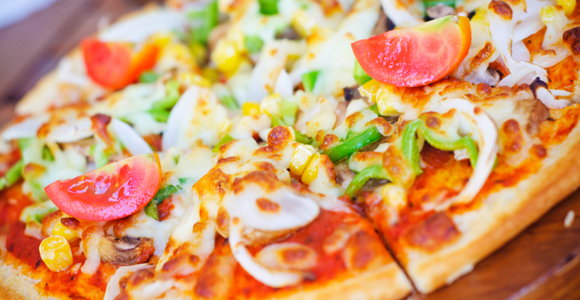So you're trying to eat healthy. Do you think pizza is off limits? Think again! Although people typically think of pizza as being a fattening food, it doesn't have to be. If prepared or ordered in the right way, pizza can be a very nutritious, delicious and low-calorie meal.
If You're Preparing Your Own Pizza
- Start off smart by making a homemade whole-grain pizza dough or purchasing a whole-grain crust at your local grocery store. A whole-grain crust provides more fiber, vitamins, minerals and antioxidants than crust made with refined flour.
- Top your pizza with a reduced-fat cheese (often marked "2% milk" cheese). Sprinkling on a reduced-fat cheese in place of full-fat cheese will slash calories and saturated fat.
- Make your own pizza sauce and don't use too much sugar or salt. Pizza sauce in a can or jar is notoriously high in both of these ingredients.
- Get creative with your crusts. Think outside the pizza box and try a roasted cauliflower crust or one made with egg whites.
- Don't forgo fruit. Apples, pears, apricots and pineapple add natural sweetness and great flavor to pizza.
- Flavor your favorite pizza pie with a lot of fresh herbs and spices. Fresh basil and oregano boost flavor, and crushed red pepper flakes add an ample amount of spice.
- Pile on a plethora of veggies. Get creative--arugula, spinach, zucchini, artichokes, pepperoncini, roasted beets--the sky's the limit here. The more veggies you add, the more fiber and flavor you'll get.
If You're Ordering Pizza
- Order thin-crust pizza and ask if they have a whole-grain pizza crust as an option. Opting for a thin-crust pizza will keep the calories down and ensures your plate is balanced with the food groups. Plus with whole grain you'll be getting beneficial vitamins and minerals as well as dietary fiber. Fiber aids with weight loss because it helps keep you full longer.
- Ask to have the cheese reduced by half. While most pizzerias won't have reduced-fat cheese as an option, you can simply use less regular cheese. A pizza with half the cheese will still be melty, gooey and delicious but will have much less saturated fat and fewer calories.
- Load up on the veggies. Veggies are really low in calories, are virtually fat-free, and are chock-full of vitamins, minerals, fiber, disease-fighting antioxidants and water. And to top that off, they're also going to add complex flavors to your pizza beyond that of the typical cheese and meat combo.
- Choose a lean protein or skip the meat altogether. Typical pizza protein options include high-fat sausage, pepperoni, hamburger and bacon. Steer clear of these calorie-bombs and opt for chicken breast, chicken sausage or Canadian bacon (which is actually a lean ham). You can even go meat-free and get an all-veggie pizza.
- Ask if the crust is brushed with oil or butter and request that they skip this step to save a ton of calories. To add flavor, you can request to have the crust brushed with garlic cloves before baking.
- Order your pizza with a red sauce rather than alfredo sauce. Red sauce is lower in fat and calories and is full of lycopene, a powerful antioxidant that may help lower your risk for cancer, heart disease and macular degeneration.
- Practice portion control. Limit yourself to only a couple of slices and enjoy a hefty garden salad with your pizza. Be sure to drink plenty of water or other calorie-free beverage to help you feel full.

Kari Hartel, RD, LD is a Registered, Licensed Dietitian and freelance writer based out of St. Louis, MO. Kari is passionate about nutrition education and the prevention of chronic disease through a healthy diet and active lifestyle. Kari holds a Bachelor of Science in Dietetics from Southeast Missouri State University and is committed to helping people lead healthy lives. She completed a yearlong dietetic internship at OSF St. Francis Medical Center in Peoria, IL, where she worked with a multitude of clients and patients with complicated diagnoses. She planned, marketed, and implemented nutrition education programs and cooking demonstrations for the general public as well as for special populations, including patients with cancer, heart disease, diabetes, Alzheimer's disease, obesity, and school-aged children. Contact Kari at [email protected].



